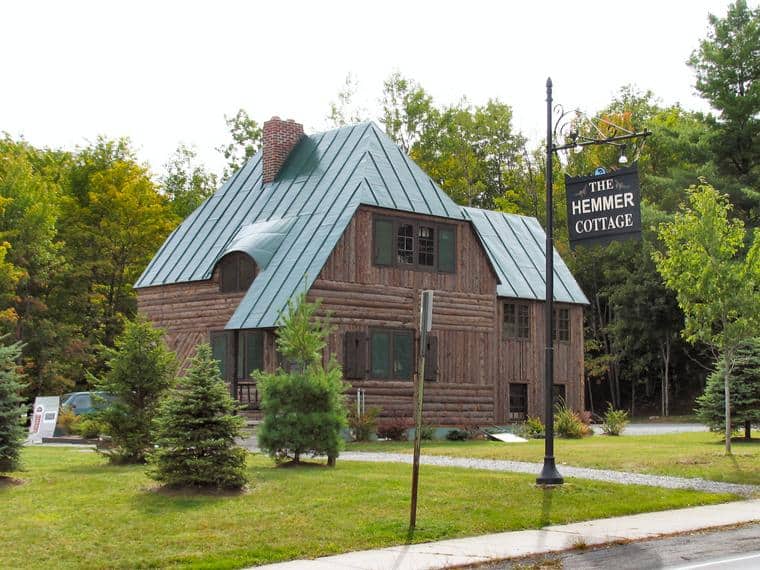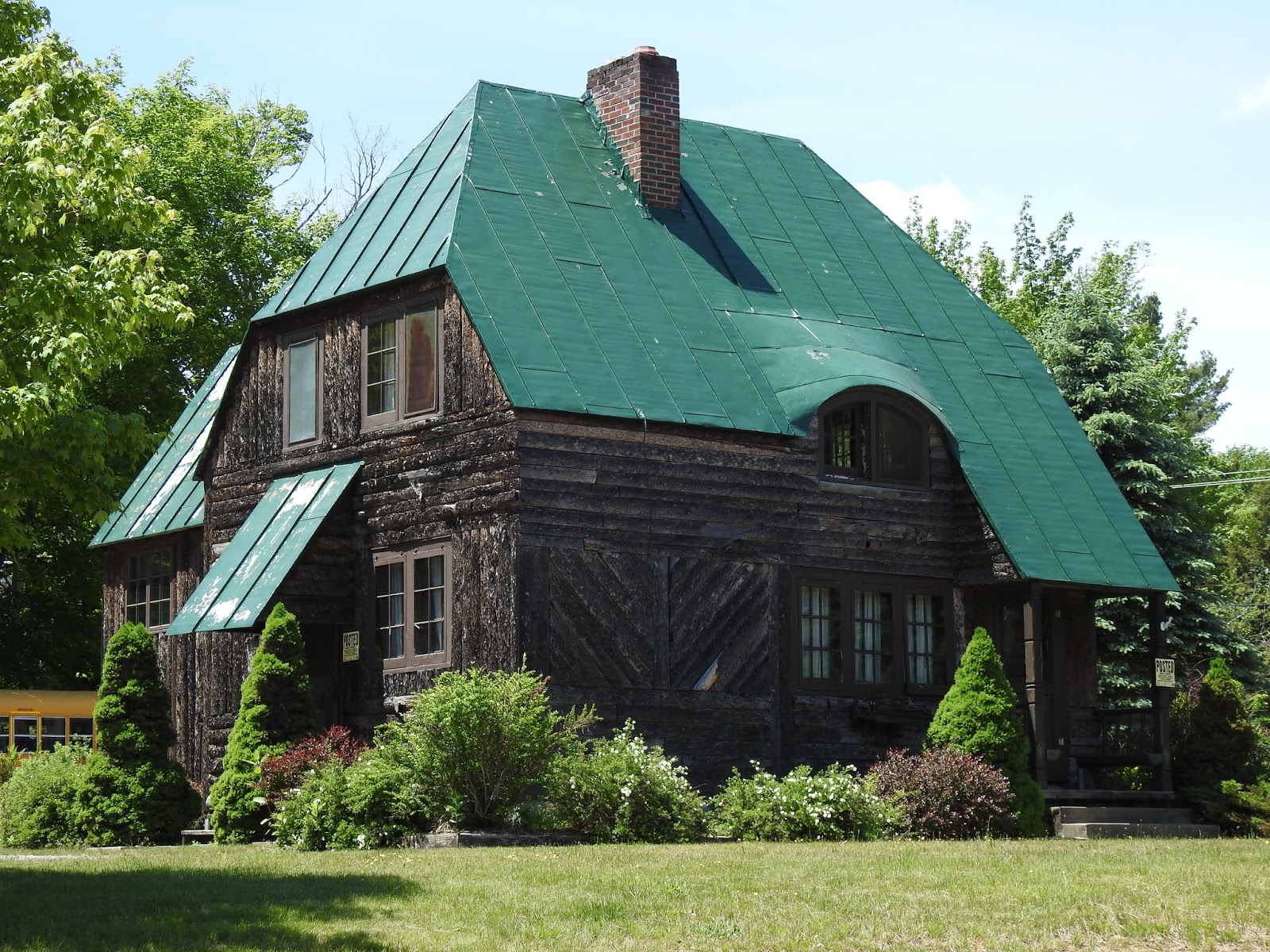Keeping House:
An Old Forge Landmark Rolls into a New HomeBy Michael Cunningham
A house moving down the street is not an every day event. When it happened in May of 2002 in Old Forge, traffic was halted. Electricity was shut off. Children gawked and old timers scratched their heads trying to remember the last time. History on wheels rolled down Park Avenue, slowly making its way to a new site near Old Forge Pond. Hemmer Cottage, bound for demolition, is also a catalyst for an important rediscovery of the Town of Webb’s heritage, and perhaps a primer for historic preservation in other small Adirondack village.
Built in 1931, Cottage Kent, as it was then called, was designed as an English-style bungalow. The two-story structure has many beautifully idiosyncratic touches: arched doors, cabinets with colorful hand-painted scenes, and leaded windows. Many of the elaborate wrought-iron hinges were forged by its designer and creator, Bernard Hemmer.
Born in Syracuse in 1896, Hemmer came to Old Forge in 1919 to recuperate as part of a government plan for disabled veterans of World War I. One source suggests he was recovering from tuberculosis. Another indicates, more likely, that he suffered from a poison gas attack.
The son of a sign painter, Hemmer began to pursue two passions: painting and developing a unique colony of vacation cabins. He designed and constructed fourteen small whimsical cottages, each one reflecting various styles of European and Scandinavian architecture and he name them so: Chateau, Switzerland, Finland, Lapland, among others.
Great care was given to details. Stairs, windows, doorways, walls and ceilings were all constructed with an inventive aesthetic. The Danmark (sic) cabin had a simulated thatched roof. Some walls were built with bottles set in cement and plaster. This construction method Hemmer claimed to have copied from the baptistry of the Cathedral of Pisa, according to a 1951 Utica Observer-Dispactch article. His pride, Chateau, housed “an Italian brick fireplace with Spanish tile mosaic.” Searching the Adirondacks and upstate New York for antiques, he filled the cottages with fine refinished pieces of early American furniture and adorned them with ancient hardware recovered from “abandoned barns and the burnt out ruins,” the newspaper reported.
“Hemmer Cottage is truly a vernacular expression of the imported, historically based cottage styles highly popularized in the early twentieth century,” comments Paula Dennis of Adirondack Architectural Heritage, in Keeseville. “Borrowing from Medieval precedent, the cottage exhibits steeply pitched roofs, with jerkin head or clipped gable ends, eyebrow dormer, and narrow window sets, all quintessential features of the romanticized European, thatched-roof cottage.”
In 1955 Hemmer sold his motel and moved into Cottage Kent. He had begun to study painting on canvas, traveling to Mexico’s University of Guanajuato School of Fine Arts. He depicted many Mexican subject, as well as Adirondack scenes, local friends and family. His mural of the Erie Canal won a prize from Utica’s Munson-Williams-Proctro Art Institute in 1958, and many of his works have been displayed at the Arts Center / Old Forge, of which he was a founding member. Hemmer lived in Old Forge until his death, in 1977. Perhaps the image best remembered by visitors is that of Bernard Hemmer himself, sitting in front of his slab-sided cottage, putting paint to canvas.

When the Town of Webb Schools, in Old Forge, expanded in 1964, the plan included purchase of the adjoining Hemmer Motel complex, with the exception of Cottage Kent. The little village was auctioned off. The cottages were dispersed to many sites, and recently several have been traced to various location around town.
Cottage Kent-now called Hemmer Cottage-passed from tenant to tenant until 1999, when the school began another major expansion. The school bought the cottage for sixty-thousand dollars and used it as the contractor’s headquarters during construction. School Superintendent Alana Kempf described the situation in 2001: “Once the project reached the point of no longer needing on-site offices, the district did not have a use of the building. We could not use the building for any instructional purposes and idd not just want to use it for storage. The board of education excessed the building and established a minimum bid for the purchase of the cottage with the stipulation that it needed to be removed by a certain date.”
A clock began ticking. Hemmer Cottage was terminal, and six month was the prognosis. Who would buy it? Could it be moved? Where would it go? Who cared? These questions launched scores of meetings and put into motion a network of people who would ultimately save the cottage from destruction.
Civic planning groups had begun to emerge in the Town of Webb in 1997 under a program sponsored by Herkimer County Community College called Communities 2000. There were focus groups and leadership training, all to encourage citizen participation in proactive community development. These “new age” models and discussions were new to Old Forge and somewhat uncomfortable at times, but when the effort brought in a six-hundered-thousand-dollar federal grant for a bike path and placed it on then Supervisor George Hiltebrandt’s desk, something fundamental changed. Fundraising for community projects – which had largely been limited to traditional raffles, bake sales and auctions – had matured to include government grant-seeking, political lobbying and organized groups of private citizens.
Oddly, a wrecking ball that razed another historic building may have been the most important factor in the formation of an active local preservation movement. The Point Building, a prominent landmark in the center of Old Forge, was in serious need of repair and was slated for removal.
A community preservation team had existed since 1998, but after a successful beautification campaign to hang flower baskets along Route 28, the group hadn’t progressed far enough to grapple with the complexities of saving the Point Building, and the former clothing store and offices came down.
The event shocked the group, and then motivated it. The Hemmer Cottage project came on the heels of the downtown razing. “The Point Building demolition galvanized our architecture-preservation team. It showed just how quickly we could lose our heritage,” said Lani Ulrich, executive director of Central Adirondack Planning for the 21st Century, based in Old Forge. “The Hemmer Cottage project was savable and doable, and it was in great structural shape. The heating and electrical costs from the previous tenant were actually quite low, and we had Peg, was was instrumental.”
Peg is Peg Masters, the newly appointed Webb town historian and a human encyclopedia of Adirondack history. Her walking tours of local architecture are not only popular and informative but have raised the consciousness of even longtime residents about the value of their buildings.
“Historic architecture links us culturally to the past and gives people a sense of place,” said Masters. “A community that works to identify and preserve historic sites and shares its rich, unique history has economic value. The fragile balance between development and preservation takes planning and commitment.”
With time growing shorts, the school twice extended the deadline for removal. Yet relocating a twenty-eight-hundred-square foot building was no small enterprise. One unanswered question: Where would it go? The center of town, the lakefront, even McCauley Mountain Ski Area? the ideas were creative, yet none overcame financial and political obstacles or the simple logistics of moving an old house.
Early in the process, the Cohen family remained in the background. Moses Cohen founded Old Forge Hardware in 1900. The capital to start the store was literally on his back; his first retail endeavor was peddling merchandises from a pack as he crisscrossed the Adirondacks. His son, the late A. Richard Cohen, managed the family business and developed it as only a graduate of the Town of Webb School and Harvard might. Dick Cohen combined financial acumen and community philanthropy, parlaying his fortune and the town’s bright future.
His daughters, Linda and Sarah Cohen, were dedicated to saving Hemmer Cottage. When the search for a site reached a critical point, they granted a piece of land on the corner of Park Avenue and South Shore Road overlooking Old Forge Pond. “Linda and Sarah walked in in the early stagehand were very firmly supportive. It meant a great deal as the process went forward to have them always reminding me that “We will make it happen,’ ” recalled Ulrich.
Having a site was an important piece of the puzzle, yet another piece was still missing: money. Donations, raffles and dinners were successful, but the reality was that moving Hemmer Cottage would cost thousands of dollars. The Hemmer Cottage Preservation Team found a solution through grants and by lobbying. New York State Senator Ray Meier, a Republican from Oneida County, secured a twenty-five-thousand-dollar member item for Old Forge. Hemmer supporters also formed a partnership with the Town of Webb Historical Association in order to use its nonprofit status for fund-raising and to create a new architectural-preservation committee.
In the spring of 2002 it became clear that the move was going to happen, yet one detail was overlooked. In their enthusiasm, preservationists failed to get a relocation permit. (The planning board was expected to grant after-the-fact permission in March of 2003.)
As Steven Dziuba of Dziuba and Son Movers, of Millerton, Pennsylvania directed Hemmer Cottage down Park Avenue on May 31 of 2002, a crowd gathered. A storm predicted for that afternoon held off, and the Town of Webb Schools elementary and senior choruses performed on the lakefront.
The two blocks from the old site to the new is a quick walk. Yet a sense of place can be lost in a short time. The fire tower on Bald Mountain, the Town Hall at Thendara – every little Adirondack community has places worth saving. Remove them and all that’s left are memories.
As Peg Masters wrote, “Destruction of trees, building and scenic vistas creates a sense of loss that change inevitably brings.” Hemmer Cottage may reveal that change can also restore a sense of place and time.
What are you waiting for?









